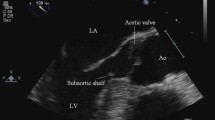Abstract
Background
Novel devices have been designed for the treatment of atrial fibrillation (AF) using minimally invasive approaches. This study aimed to determine the usefulness of a sheep model for training in cardiac surgical ablation using a minimally invasive approach in an experimental hands-on training course.
Methods
After initial training using a laparoscopic pelvic trainer, 15 sheep were subjected to surgery by six thoracic surgeons attending a hands-on thoracoscopic course. Dissection to the posterior wall of the pulmonary veins was followed by insertion of a microwave device around both the caudal cava vein and the pulmonary veins. The complications were recorded, and the effectiveness of the surgery was evaluated by complete deployment of the microwave device. The animals were killed after completion of the procedure.
Results
Isolation of the cava vein and the pulmonary veins and placement of the microwave probe were performed successfully for 10 animals using a complete thoracoscopic approach. Two animals died during the procedure. The main complications of the procedure were hemorrhage and difficulty isolating the blood vessels using a minimally invasive procedure. After the training period, the thoracoscopic surgical maneuvers were accurate and reliable.
Conclusion
The technical feasibility of performing safe and efficient thoracoscopic placement of a microwave device in a sheep model was demonstrated in this study, suggesting that the results of this study are a useful contribution to the development of an animal model for surgical training and experimental cardiac surgeries.


Similar content being viewed by others
References
Nitta T (2005) Surgery for atrial fibrillation. Ann Thorac Cardiovasc Surg 11:154–158
Hirosawa K, Sekiguchi M, Kasanuki H, Kimata S, Kaneko N, Nakamura K, Aosaki M, Takahashi S, Kondo M (1987) Natural history of atrial fibrillation. Heart Vessels Suppl 2:14–23
Geidel S, Ostermeyer J, Lass M, Boczor S, Kuck KH (2003) Surgical treatment of permanent atrial fibrillation during cardiac surgery using monopolar and bipolar radiofrequency ablation. Indian Pacing Electrophysiol J 3:93–100
Fuster V, Ryden LE, Cannom DS et al (2007) ACC/AHA/ESC 2006 guidelines for the management of patients with atrial fibrillation: executive summary. Rev Port Cardiol 26:383–446
Koistinen J, Valtonen M, Savola J, Airaksinen J (2007) Thoracoscopic microwave ablation of atrial fibrillation. Interact Cardiovasc Thorac Surg 6:695–698
Pruitt JC, Lazzara RR, Ebra G (2007) Minimally invasive surgical ablation of atrial fibrillation: the thoracoscopic box lesion approach. J Interv Card Electrophysiol 20:83–87
Pruitt JC, Lazzara RR, Dworkin GH, Badhwar V, Kuma C, Ebra G (2006) Totally endoscopic ablation of lone atrial fibrillation: initial clinical experience. Ann Thorac Surg 81:1325–1330
Poa L (2006) Thoracoscopic ablation for treatment of atrial fibrillation: a 2-port approach. Heart Surg Forum 9:E590–E591
Saltman AE (2007) Minimally invasive surgery for atrial fibrillation. Semin Thorac Cardiovasc Surg 19:33–38
Ferguson J, Walker W (2006) Developing a VATS lobectomy programme: can VATS lobectomy be taught? Eur J Cardiothorac Surg 29:806–809
Iwasaki A, Moriyama S, Shirakusa T (2008) New trainer for video-assisted thoracic surgery lobectomy. Thorac Cardiovasc Surg 56:32–36
Iwasaki A, Okabayashi K, Shirakusa T (2003) A model to assist training in thoracoscopic surgery. Interact Cardiovasc Thorac Surg 2:697–701
Hamilton EC, Scott DJ, Fleming JB, Rege RV, Laycock R, Bergen PC, Tesfay ST, Jones DB (2002) Comparison of video trainer and virtual reality training systems on acquisition of laparoscopic skills. Surg Endosc 16:406–411
Usón J, Sánchez FM, Sánchez MA, Pérez FJ, Hashizume M (2007) Principios básicos. In: Usón J, Sánchez FM, Pascual S, Climent S (eds) Formación en Cirugía Laparoscópica Paso a Paso, 3rd edn. Centro de Cirugía de Mínima Invasión, Cáceres, pp 21–89
Addis A, Vanosi G, Manasse E, Mainetti M, Monaco A, Addis F (2007) An experimental sheep model used to develop an ablation procedure for chronic atrial fibrillation. Surg Endosc 21:1626–1630
Cox JL, Ad N, Palazzo T, Fitzpatrick S, Suyderhoud JP, DeGroot KW, Pirovic EA, Lou HC, Duvall WZ, Kim YD (2000) Current status of the Maze procedure for the treatment of atrial fibrillation. Semin Thorac Cardiovasc Surg 12:15–19
Schaff HV, Dearani JA, Daly RC, Orszulak TA, Danielson GK (2000) Cox-Maze procedure for atrial fibrillation: Mayo Clinic experience. Semin Thorac Cardiovasc Surg 12:30–37
Damiano RJ, Voeller RK (2006) Surgical and minimally invasive ablation atrial fibrillation. Curr Treat Cardiovasc Med 8(5):371–376
Manasse E, Infante M, Ghiselli S, Cariboni U, Alloisio M, Barbone A, Addis A, Gallotti R (2002) A video-assisted thoracoscopic technique to encircle the four pulmonary veins: a new surgical intervention for atrial fibrillation ablation. Heart Surg Forum 5:337–339
Williams MR, Knaut M, Berube D, Oz MC (2002) Application of microwave energy in cardiac tissue ablation: from in vitro analyses to clinical use. Ann Thorac Surg 74:1500–1505
Cox JL (2004) The role of surgical intervention in the management of atrial fibrillation. Tex Heart Inst J 31:257–265
Szabo Z, Avery GJ, Sandor A, Litwin DE (2000) Suturing and knotting techniques for thoracoscopic cardiac surgery. Surg Clin North Am 80:1555–1574
Nickel R, Schummer A, Wilkens H, Vollmerhaus B, Habermehl K-H (1981) The circulatory system, the skin, and the cutaneous organs of the domestic mammals. In: Nickel R, Seiferle E (eds) The anatomy of the domestic animals, vol 3. Verlag Paul Parey, Berlin, p 610
La Meir M, De Roy L, Blommaert D, Buche M (2007) Treatment of lone atrial fibrillation with a right thoracoscopic approach. Ann Thorac Surg 83:2244–2245
Acknowledgments
This study was supported in part by Consejería de Infraestructuras y Desarrollo Tecnológico (Project IPR99A027). The authors are especially grateful to Dr. Rafael Lima, Dr. Laura Luis, and Dr. María Fernanda Martín for their anesthetic assistance.
Author information
Authors and Affiliations
Corresponding author
Rights and permissions
About this article
Cite this article
Sánchez-Margallo, F.M., Díaz-Güemes, I., Pérez, F.J. et al. Preliminary results with a training program for thoracoscopic atrial fibrillation therapy. Surg Endosc 23, 1882–1886 (2009). https://doi.org/10.1007/s00464-008-0197-1
Received:
Revised:
Accepted:
Published:
Issue Date:
DOI: https://doi.org/10.1007/s00464-008-0197-1




